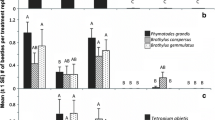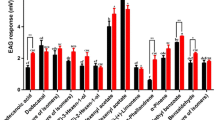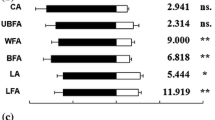Abstract
The attractiveness of representative host materials, host extracts, and individual host volatiles (primarily carboxylic acids, alcohols, and esters) toCarpophilus hemipterus (L.) (Coleoptera: Nitidulidae) adults in wind-tunnel bioassays was examined. Attractiveness of the materials was examined alone and in combination with the aggregation pheromone. Host materials and extracts were often attractive on their own, and the attractancy was synergized when they were combined with the pheromone. Propanoic and butanoic acids, methanol, 2-propanol, 1-heptanol, methyl butanoate, and propanal were among the most effective attractants relative to the pheromone, but many other compounds significantly synergized the pheromone (typically three- to four fold). Attractiveness and synergism were influenced by the carbon chain length and branching of the substitutents. Straight-chain compounds that had at least three carbon atoms were generally effective as synergists. Many branched-chain compounds were also effective synergists. In general, the degree of attractiveness and synergism could be predicted fairly well with the physicochemical steric (Es) parameter, although the lipophilicity (Pi) parameter also appeared to be useful in explaining the lower activity of short-chain substituents. Thus, many compounds that had only limited attractiveness on their own may nevertheless play and important role in synergizing the pheromone. Structure-activity studies appear to be appropriate not only for determining optimal attractants for these insects, but also for determining effective synergists for the pheromone.
Similar content being viewed by others
References
Alm, S.R., Hall, F.R., Ladd, T.L., Jr., andWilliams, R.N. 1985. A chemical attractant forGlischrochilus quadrisignatus (Coleoptera: Nitidulidae).J. Econ. Entomol. 78:839–843.
Alm, S.R., Hall, F.R., McGovern, T.P., andWilliams, R.N. 1986. Attraction ofGlischrochilus quadrisignatus (Coleoptera: Nitidulidae) to semiochemical: Butyl acetate and propyl propionate.J. Econ. Entomol. 79:654–658.
Amos, T.G. 1969. Reactions ofCarpophilus spp. (Coleoptera, Nitidulidae) to humidity with reference to gradient steepness.Anim. Behav. 17:9–13.
Amos, T.G., andWaterhouse, F.L. 1967. Plastic behavior shown by twoCarpophilus spp. (Coleoptera, Nitidulidae) in various humidity gradients and its ecological significance.Oikos 18:345–350.
Bartelt, R.J., Schaner, A.M., andJackson, L.L. 1988. Aggregation pheronomesmDrosophila borealis andDrosophila littoralis.J. Chem. Ecol. 14:1319–1327.
Bartelt, R.J., Dowd, P.F., Plattner, R., andWeisleder, D., 1990a. Aggregation pheromone of the driedfruit beetle,Carpophilus hemipterus: Wind-tunnel bioassay and identification of novel tetraene hydrocarbon components.J. Chem. Ecol. 16:1015–1039.
Bartelt, R.J., McGuire, M.R., andBlack, D.A. 1990b. Feeding stimulants for the European corn borer (Lepidoptera: Pyralidae): Additives to a starch-based formulation forBacillus thuringiensis.Environ. Entomol. 19:182–189.
Birch, M.C. 1984. Aggregation in bark beetles, pp. 331–353in W.J. Bell and R.J. Cardé (eds.), Chemical Ecology of Insects. Sinauer Assoc. Sunderland, Massachusetts.
Blackmer, J.L., andPhelan, P.L. 1988. Flight behavior ofCarpophilus hemipterus (L.) (Coleoptera: Nitidulidae): Transition from dispersive to vegetative flight. Proceedings XVIII International Congress on Entomology, p. 217.
Bouchier, R.S., andStewart, R.K. 1986. Attraction ofGlischrochilus quadrisignatus (Coleoptera: Nitidulidae) adults to food plant volatiles.Proc. Entomol. Soc. Manitoba 42:37.
Burkholder, W.E. 1988. Some new lures, traps, and sampling techniques for monitoring storedproduct insects. Proceedings XVIII International Congress on Entomology, p. 444.
Buttery, R.G., Ling, L.C., andChan, B.G. 1978. Volatiles of corn kernels and husks: possible corn earworm attractants.J. Agric. Food Chem. 26:866–869.
Buttery, R.G., Ling, L.C., andR., Teranishi, 1980. Volatiles of corn tassels: Possible corn ear worm attractants.J. Agric. Food Chem. 28:771–774.
Dowd, P.F. 1987. A labor-saving method for rearing the driedfruit beetle (Coleoptera: Nitidulidae) on pinto bean-based diet.J. Econ. Entomol. 80:1351–1353.
Dupaigne, P. 1970. The aroma of pineapples.Fruits 25:793–805.
Fienberg, S.E. 1977. The Analysis of Cross-Classified Categorical Data. MIT Press, Cambridge, Massachusetts. 151 pp.
Flath, R.A., Forey, R.R., John, J.O., andChan, B.C. 1978. Volatile components of corn silk (Zea mays L.): PossibleHeliothis sea (Boddie) attractants.J. Agric. Food Chem. 26:1290–1293.
Fogleman, J.C. 1982. The role of volatiles in the ecology of cactophilicDrosophila, pp. 191–206,in J.S.F. Barker and W.T. Starmer (eds.). Ecological Genetics and Evolution: The Cactus-Yeast-Drosphila Model System. Academic Press, New York.
Hansch, C., andLeo, A. 1979. Substituent Constants for Correlation Analysis in Chemistry and Biology. Wiley, New York. 339 pp.
Hinton, H.E. 1945. A Monograph of the Beetles Associated with Stored Products. Jarrold and Sons, Norwich, England. 443 pp.
Jennings, W.G. 1977. Volatile components of figs.Food Chem. 2:185–191.
Jones, O.T. 1985. Chemical mediation of insect behavior, pp. 311–373,in D.H. Hutson and T.R. Roberts (eds.). Progress in Pesticide Biochemistry and Toxicology, Vol. 5, Insecticides. Wiley, New York.
Lussenhop, J.L., andWicklow, D.T. 1990. Nitidulid beetles as a source ofAspergillus flavus infective inoculum.Trans. Jpn. Mycol. Soc. 31:63–74.
MacLeod, A.J., andDe Troconis, N.G. 1982. Volatile flavour components of guava.Phytochemistry 21:1339–1342.
Metcalf, R.L. 1987. Plant volatiles as insect attractants.C.R.C. Critical Rev. Plant Sci. 5:251–300.
Miller, M.W. 1952. Yeast associated with the dried-fruit beetle in figs.Proc. Cal. Fig. Inst. 6:8–9.
Miller, M.W., andMrak, E.M. 1954. Yeast associated with dried-fruit beetles in figs.Appl. Environ. Microbiol. 1:174–178.
Oehlschlager, A.C., Pierce, A.M., Pierce, H.D., Jr. andBorden, J.H. 1988. Chemical communication in cucujid grain beetles.J. Chem. Ecol. 14:2071–2098.
SAS Institute. 1985. SAT/STAT Guide for Personal Computers, Version 6. SAS Institute, Cary, North Carolina.
Smilanick, J. 1979. Colonization of ripening figs byCarpophilus spp.J. Econ. Entomol. 72:557–559.
Smilanick, J.M., Ehler, L.E., andBirch, M.C. 1978. Attraction ofCarpophilus sp. to volatile compounds of figs.J. Chem. Ecol. 4:700–701.
Walgenbach, C.A., Burkholder, W.E., Curtis, M.J., andKhan, Z.A. 1987. Laboratory trapping studies withSitophilus zeamais (Coleoptera: Curculionidae).J. Econ. Entomol. 80:763–767.
Warner, R.M. 1960. Area baiting to controlDrosophila and nitidulid beetles.Proc. Cal. Fig Inst. 14:35–38.
Warner, R.M. 1961. Area baiting program 1960 results.Proc. Cal. Fig Inst. 15:36–40.
Author information
Authors and Affiliations
Additional information
The mention of firms or trade names does not imply that they are endorsed or recommended by the U.S. Department of Agriculture over other firms or similar products not mentioned.
Rights and permissions
About this article
Cite this article
Dowd, P.F., Bartelt, R.J. Host-derived volatiles as attractants and pheromone synergists for driedfruit beetleCarpophilus hemipterus . J Chem Ecol 17, 285–308 (1991). https://doi.org/10.1007/BF00994333
Received:
Accepted:
Issue Date:
DOI: https://doi.org/10.1007/BF00994333




